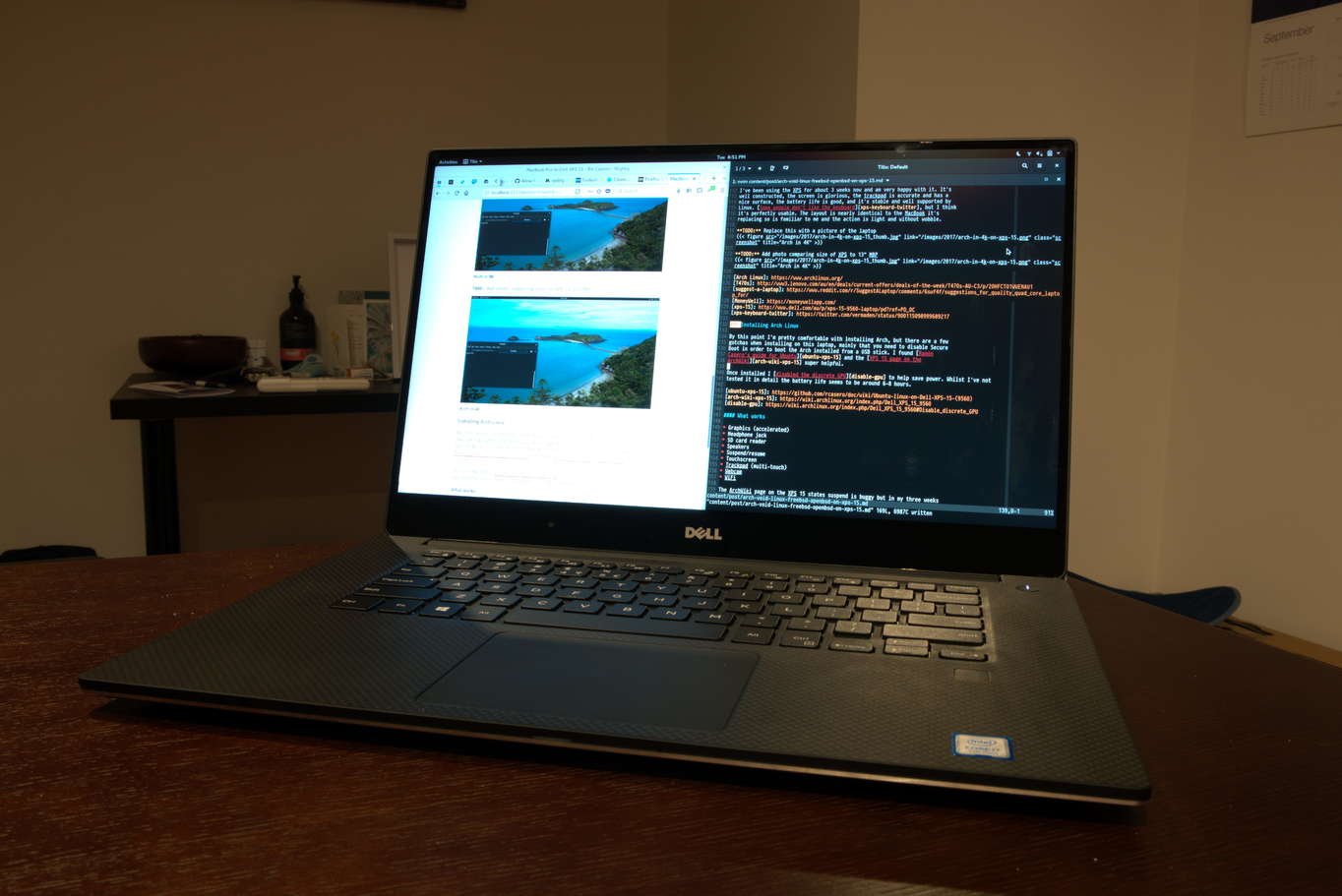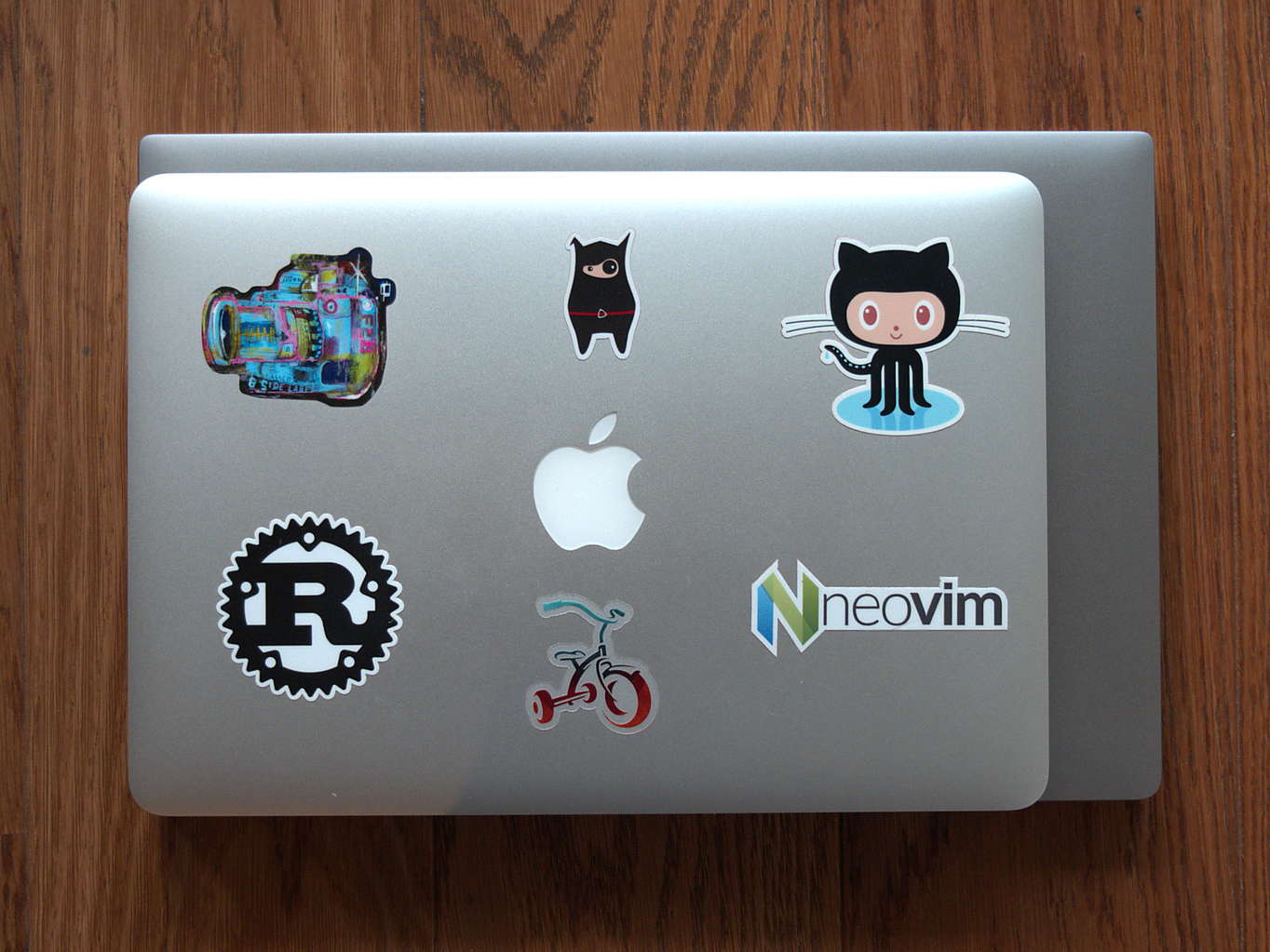Replacing a MacBook Pro
This is the fourth post in my series on finding an alternative to Mac OS X. Part 3 was about finding replacements for some of my favourite Mac productivity apps.
My migration away from Mac OS X is still going well. I rarely use Mac OS anymore. The one remaining application I'm yet to find a suitable replacement for is MoneyWell.
Update 30 March 2019: I have discovered Buckets and will be trialling it as a MoneyWell replacement.
In April I started a new job and was given the choice between a Mac or PC laptop. I took the PC option and was supplied with a Lenovo ThinkPad T470s, which I run Arch Linux on.
ThinkPads are very well regarded by folks that run, and build open source operating systems. They are often recommended when people ask what laptop they should get for running Linux or BSD. Their hardware is typically well supported particularly the keyboards. Personally I use a mechanical keyboard whenever possible so consider most laptop keyboards to be of a similar level of mediocrity.
Using my three year old 2013 13" MacBook Pro as my benchmark I have not formed a positive opinion of my ThinkPad. The hardware support has been mostly good but overall it's quite a lacklustre laptop. Granted it is a, "business", model and is about AU$600 cheaper than a current model 13" MacBook Pro.
My gripes with the ThinkPad are:
- The screen is low resolution (~153 dpi vs. MacBook's 227 dpi) and has poor colour reproduction — colours lack vibrancy and look washed out.
- The trackpad is imprecise, slow to respond and has a grippy surface.
- About once a day the fan stays on full after resuming from suspend. Closing and opening it again will often restore normal behaviour, but not always. In the latter case shutting down and restarting is needed. Note that the fan is controlled by the embedded controller (part of the firmware), not the OS. Several BIOS updates have still not resolved the issue.
- The general construction lacks rigidity. Using the laptop on my bus commute often results in the screen wobbling or changing position.
These gripes eventually led me to start leaving the ThinkPad at work and using my (slower) 2013 13" MacBook Pro (running Arch Linux) on the commute. The MacBook has a far superior display that doesn't wobble or change position on the bus, the trackpad is vastly more accurate and pleasant to use, and the fan behaves sensibly.
Whilst the MacBook works well as a Linux machine I recently started to entertain the idea of replacing it with a more powerful quad core laptop. I spent a lot of time researching PC laptops and discovered that there are a minuscule number that are all of the following:
- Quad core
- Well constructed, rigid, ideally made from metal
- 13–15" HiDPI screen
- Runs Linux (and maybe BSD) well
- Aren't ridiculously styled gaming laptops
- Equal or less than the cost of a 15" MacBook Pro
I even ended up asking for help on Reddit.
After receiving three recommendations for the Dell XPS 15 (9560) from friends (two using Linux on it, one Windows), I sucked up the extra cost over my AU$2500 budget and ordered one. I won't go into detail about the Dell ordering and delivery experience but I will say it's complex, ugly, and slow.

My laptop
The specifications of my unit are:
| Component | Description |
|---|---|
| CPU | Quad Intel Core i7-7700HQ CPU (Base: 2.80GHz, Turbo: 3.80GHz) |
| Memory | 32Gb DDR4-2400MHz |
| SSD | 1Tb Toshiba NVMe |
| Graphics | Intel graphics + Nvidia GeForce GTX 1050 4GB GDDR5 Mobile GPU |
| Display | 15.6" 4K (3840 x 2160) IGZO IPS display with touchscreen |
| WiFi | Qualcomm Atheros QCA6174 802.11ac Wireless Network Adapter |
Is It Any Good?
I've been using the XPS for about 3 weeks now and am very happy with it. It's well constructed, the screen is glorious, the trackpad is accurate and has a nice surface, the battery life is good, and it's stable and well supported by Linux. Some people don't like the keyboard, but I think it's perfectly usable. The layout is nearly identical to the MacBook it's replacing so it's familiar to me and the action is light and without wobble.

13-inch MacBook Pro Compared to XPS 15

13-inch MacBook Pro Height Compared to XPS 15
Installing Arch Linux
My first step upon receiving the laptop was to resize the Windows partition to make room for other operating systems. I don't expect to use Windows outside of the occasional game or BIOS update, but figured it was worth keeping around just in case.
By this point I'm pretty comfortable with installing Arch, but there are a few gotchas when installing on this laptop. The main ones are disabling Secure Boot to boot the Arch install ISO and changing the SATA mode from RAID to AHCI to make the drive visible to Linux.
I found Ramón Casero's guide for Ubuntu and the XPS 15 page on the ArchWiki super helpful. In particular Ramón describes the steps needed to not break the Windows installation when changing the SATA mode.
Once Arch was installed I disabled the discrete GPU to help save power. Whilst I've not tested it in detail the battery life seems to be around 6–8 hours.
What works
- Graphics (accelerated)
- Headphone jack
- SD card reader
- Speakers
- Suspend/resume
- Touchscreen
- Trackpad (multi-touch)
- Webcam
- WiFi
The ArchWiki page on the XPS 15 states resuming from suspend is buggy but in my use it's been totally stable (4.12.8-2-ARCH kernel).
What doesn't work
- Fingerprint scanner
What I haven't tried
- Bluetooth
This is part 4 in a series. Read Part 5